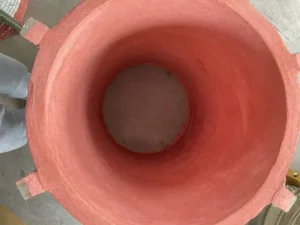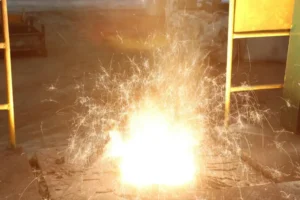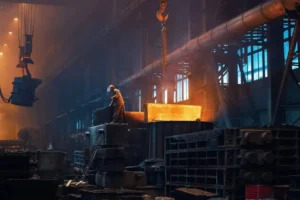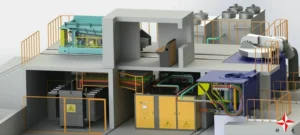หนึ่ง การเหนี่ยวนำ เตาอุ่น เป็นอุปกรณ์ที่ใช้หลักการของการเหนี่ยวนำแม่เหล็กไฟฟ้าเพื่อวัสดุนำไฟฟ้าความร้อน, โดยทั่วไปแล้วโลหะ. มันทำงานได้โดยการวางขดลวดเหนี่ยวนำ, พกพากระแสสลับความถี่สูง, ใกล้ชิ้นงาน. สิ่งนี้สร้างสนามแม่เหล็กที่แปรผันตามเวลา. เมื่อมีการวางวัสดุที่เป็นตัวนำภายในสนามแม่เหล็กนี้, กระแสน้ำวน ถูกเหนี่ยวนำในนั้น. เนื่องจากความต้านทานไฟฟ้าโดยธรรมชาติของวัสดุ, กระแสน้ำวนเหล่านี้จะถูกแปลงเป็นความร้อน, การทำความร้อนแบบไม่สัมผัสของวัสดุ.

เตาทำความร้อนแบบเหนี่ยวนำทำงานอย่างไร
- การเหนี่ยวนำแม่เหล็กไฟฟ้า: เมื่อกระแสไฟฟ้าสลับกระแสสูงไหลผ่านขดลวดเหนี่ยวนำ, มันสร้างสนามแม่เหล็กที่ผันผวนรอบ ๆ มัน.
- กระแสน้ำวน: เมื่อวัสดุนำไฟฟ้า (ชิ้นงาน) ที่จะให้ความร้อนถูกวางไว้ในสนามแม่เหล็กสลับนี้, กระแสเหนี่ยวนำ, รู้จักกันในชื่อ Eddy Currents, ถูกสร้างขึ้นภายในชิ้นงานในรูปแบบการหมุนวน, ตามกฎการเหนี่ยวนำแม่เหล็กไฟฟ้าของฟาราเดย์.
- Joule Heating: เมื่อกระแสไหลวนไหลภายในชิ้นงาน, พวกเขาสร้างความร้อนเนื่องจากความต้านทานไฟฟ้าของวัสดุ (Joule Effect), ทำให้อุณหภูมิของชิ้นงานเพิ่มขึ้น.
- การสูญเสียฮิสเทรีซิส (สำหรับวัสดุแม่เหล็ก): สำหรับวัสดุแม่เหล็กเช่นเหล็กและเหล็กกล้า, นอกจากความร้อนที่เกิดจากกระแสวน, สนามแม่เหล็กสลับยังทำให้เกิดการพลิกโดเมนแม่เหล็กอย่างรวดเร็วภายในวัสดุ, นำไปสู่การสูญเสีย hysteresis, ซึ่งเพิ่มความร้อนต่อไป.
- ผลกระทบต่อผิวหนัง: เมื่อความถี่ของกระแสสลับเพิ่มขึ้น, กระแสน้ำวนมีแนวโน้มที่จะไหลเข้าใกล้พื้นผิวของชิ้นงานอย่างเข้มข้นมากขึ้น. ปรากฏการณ์นี้เรียกว่า ผลกระทบต่อผิวหนัง. สิ่งนี้ช่วยให้การเหนี่ยวนำให้ความร้อนได้อย่างรวดเร็ว, ความร้อนที่แปลเป็นภาษาท้องถิ่นของพื้นผิวชิ้นงาน.
การใช้เตาเผาเครื่องทำความร้อนแบบเหนี่ยวนำ
เตาเผาเครื่องทำความร้อนแบบเหนี่ยวนำมีการใช้กันอย่างแพร่หลายในการผลิตอุตสาหกรรมเนื่องจากประสิทธิภาพของพวกเขา, ความแม่นยำ, ความสะอาด, และความสะดวกในการควบคุม. แอปพลิเคชันหลักของพวกเขารวมถึง:
- การหลอมโลหะ: ใช้สำหรับละลายโลหะต่าง ๆ และโลหะผสมของพวกเขา, เช่นเหล็ก, เหล็ก, สแตนเลส, ทองแดง, อลูมิเนียม, และโลหะมีค่า. เตาหลอมหลอมละลายได้รับการหลอมละลายอย่างรวดเร็วและมีประสิทธิภาพ, และเอฟเฟกต์กวนที่เกิดจากสนามแม่เหล็กช่วยให้มั่นใจว่าองค์ประกอบโลหะผสมสม่ำเสมอ.
- การบำบัดความร้อน:
- การทำให้แข็ง (การดับ): ความร้อนและความเย็นอย่างรวดเร็วเพื่อเพิ่มความแข็งและความต้านทานการสึกหรอของวัสดุโลหะ. การทำให้ชุบแข็งแบบเหนี่ยวนำช่วยให้การทำความร้อนในพื้นที่เฉพาะของพื้นที่ทำงาน, ลดการเสียรูปโดยรวม.
- การหลอม: ใช้เพื่อบรรเทาความเครียดภายในในโลหะ, การปรับปรุงความเหนียวและความทนทานของพวกเขา.
- การแบ่งเบาบรรเทา: หลังการแข็งตัว, ชิ้นงานถูกอุ่นขึ้นถึงอุณหภูมิที่ต่ำกว่าเพื่อปรับความแข็งและความทนทาน.
- การทำคาร์บูร์: การรักษาพื้นผิวของโลหะเพื่อเพิ่มความแข็งของพื้นผิวโดยการแนะนำคาร์บอน.
- ความร้อนล่วงหน้าสำหรับการปลอม: บิลเล็ตโลหะให้ความร้อนอย่างรวดเร็วก่อนที่จะสร้างพลาสติกให้ดีขึ้น, ลดการเสียรูป, และลดการยืดงานที่ตามมาให้น้อยที่สุด.
- การประสาน และการเชื่อม:
- การประสาน: การเข้าร่วมชิ้นส่วนโลหะสองชิ้นขึ้นไปโดยใช้โลหะฟิลเลอร์ที่มีจุดหลอมเหลวต่ำกว่าชิ้นงาน. การประสานการเหนี่ยวนำให้ประสิทธิภาพการใช้พลังงาน, ผลผลิตสูง, และการทำซ้ำที่ดี.
- การเชื่อม: ตัวอย่างเช่น, การเชื่อมหลอด, ในกรณีที่ความร้อนแบบเหนี่ยวนำนำขอบท่อไปยังอุณหภูมิการเชื่อมก่อนที่จะถูกเชื่อมแรงดัน.
- หด การปรับให้เหมาะสม / ถอดชิ้นส่วน: การใช้การขยายตัวทางความร้อนและการหดตัวของโลหะ, ส่วนประกอบจะถูกทำให้ร้อนเพื่อขยายสำหรับการประกอบหรือถอดประกอบหลังความร้อน.
- การเผา: ในผงโลหะวิทยา, ใช้สำหรับการเผาผงโลหะเพื่อให้แข็งตัวให้เป็นรูปร่างที่ต้องการ.
- การอัดรีด: บิลเล็ตโลหะให้ความร้อนสำหรับการขึ้นรูปแบบรีด.
- ที่มีความเชี่ยวชาญ การใช้งาน:
- ในอุตสาหกรรมเซมิคอนดักเตอร์, สำหรับความร้อนซิลิคอนหรือวัสดุเซมิคอนดักเตอร์อื่น ๆ.
- ตัวนำความร้อนของเหลว (เหมือนโลหะหลอมเหลว) และพลาสมา.
- สารทำความร้อน (เช่น, ร่องรอยกราไฟท์ที่มีวัสดุอื่น ๆ).
- การปรับปรุงประสิทธิภาพการใช้พลังงานในเครื่องฉีดพลาสติก.
ที่ เตาทำความร้อนเหนี่ยวนำ เป็นเทคโนโลยีความร้อนที่ทันสมัยที่มีบทบาทที่ขาดไม่ได้ในสาขาอุตสาหกรรมหลายแห่งเนื่องจากวิธีการทำความร้อนแบบไม่เป็นเอกลักษณ์และประสิทธิภาพที่ยอดเยี่ยม.







